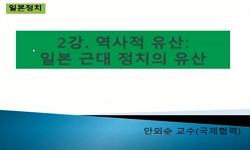전후 일본의 정치는 다방체제를 거쳐 소위 55년 체제 출범을 계기로 보혁구도라고 하는 정치체제의 제도화에 성공하였고, 자민당은 1993년까지 38년 동안 우월정당으로서 장기집권해 왔다. 정...
http://chineseinput.net/에서 pinyin(병음)방식으로 중국어를 변환할 수 있습니다.
변환된 중국어를 복사하여 사용하시면 됩니다.
- 中文 을 입력하시려면 zhongwen을 입력하시고 space를누르시면됩니다.
- 北京 을 입력하시려면 beijing을 입력하시고 space를 누르시면 됩니다.
https://www.riss.kr/link?id=T8934183
- 저자
-
발행사항
부산 : 東亞大學校 大學院, 2001
- 학위논문사항
-
발행연도
2001
-
작성언어
한국어
- 주제어
-
KDC
340.9 판사항(4)
-
발행국(도시)
부산
-
형태사항
iv, 113p. ; 26cm
-
일반주기명
참고문헌: p. 103-111
- 소장기관
-
0
상세조회 -
0
다운로드
부가정보
국문 초록 (Abstract)
전후 일본의 정치는 다방체제를 거쳐 소위 55년 체제 출범을 계기로 보혁구도라고 하는 정치체제의 제도화에 성공하였고, 자민당은 1993년까지 38년 동안 우월정당으로서 장기집권해 왔다. 정치학자들은 자민당을 유지시켜 온 원동력은 보수주의에 기초한 파벌간의 세력균형이며, 여기서 도출되는 타협과 협상이 장기집권에 기여한 요소로 보고 있다.
정치경제적 배경에서 보면 일본의 파벌은 戰國時代의 封養制度, 德川幕府時代의 幕潘體制, 明治維新 직후의 藩閥政治, 그리고 1차대전 이후의 軍閥政浩에서 그 연원을 찾을 수 있다. 사회구조적 배경에서 일본의 파벌은 충과 효를 강조하는 유교에서 비롯되는 전통적 가족제도, 경쟁적 동조를 강조하는 和의 정신, 幕府시대의 쇼군(裝軍)-다이묘-사무라이로 이어지는 질서와 권위 중심의 지배체제, 그리고 오야붕 - 꼬봉이라는 위계적 신분관계에 그 근거를 두고 있다.
자민당 내에서 파벌이 형성된 요인은 태생적인 측면과 제도적 측면이 있다. 태생적으로는 55년체제 출범에 따라 대중정당 성격의 결여에서 그 요인을 찾아 볼 수 있다. 자민당은 지구당이라는 공조직이 아닌 후원회라는 의원의 개인조직에 의해 운영되기 때문에 의원정당의 성격이 강하다. 제도적 요인으로서 총재공선제와 중선거구제를 들 수 있다. 총재공선제에 따른 총재선출과정에는 다수의원의 지지가 필요하기 때문에 자민당내에서의 파벌 형성은 피할 수 없다. 일본의 국회의원 선거방식은 중선거구제도를 채택하기 때문에 자민당은 1998년 이전까지 복수공천 방식을 택하였다. 이러한 제도하에서 출마희망자는 공천에 유리한 파벌을 택하게 되고 파벌영수는 자파후보를 공천하고 당선시키기 위해 당내 경쟁을 하게 된다.
파벌의 지도자는 조직을 운영하기 위해 자금조달능력, 인재충원능력, 당내에서의 발언권, 그리고 정부에 대한 영향력을 구비해야 한다. 파벌 영수는 조직운영에 필요한 자금을 재계에 의존하며, 재계는 정당이나 파벌에 낸 정치자금을 일종의 투자로 간주하고 있다. 따라서 자민당의 파벌은 합종연횡과 같은 세력 논리에 집착함으로써 정경유착, 금권정치의 사슬에 얽매이는 결과를 초래하였다.
자민당의 파벌은 黨中黨이라는 구도속에서 파벌간의 擬似政權交替를 이룩함으로써 권력이 전제주의 정치체제로 변질되거나 절대적 부패현상으로 이어지지는 것을 예방했으며, 당내의 정치활성화에도 기여했다고 평가할 수 있다. 특히 자민당의 파벌정치는 당내 민주화에 기여했으며 파벌을 하나의 정치체제로 인정할 경우 유럽식의 협의민주주의 모델에 해당된다는 평가를 받고 있다. 자민당은 파벌의 순기능을 최대한 살리면서 신보수주의하에서 정치개혁을 추진하고 있다. 정치개혁의 주요 내용으로는 정치자금규정법의 강화, 중선거구제의 소선거구비례대표병립제 전환, 정당조성법과 정치윤리법의 개정을 들 수 있다.
자민당은 과거와 같은 파벌의 극한 대립에서 벗어나 정치자금문제에 중점을 두고 개혁을 추진할 것으로 전망된다. 또한 파벌간에는 정책본위의 경쟁을 펼치면서 야당과는 정책연합을 통한 정권유지에 노력할 것으로 본다. 자민당의 파벌정치는 다원주의하에서 대화와 타협을 통한 파벌 상호간의 견제와 균형을 꾀하고 있기 때문에 협의민주주의 원리인 상생의 정치를 최대한 구현해 나가고 있다. 따라서 자민당식의 협의민주주의는 정당간, 정당 내부간에 갈등을 빚고 있는 국가들에게 정치발전을 위한 하나의 모델로서 제시해 볼 수 있을 것이다.
다국어 초록 (Multilingual Abstract)
Postwar Japan's politics succeeded in institutionization of political structure as the conservative and progressive confrontation together with sailing of the so-called 1955's system through a multiparty system, and for 38 years since then to 1993 the...
Postwar Japan's politics succeeded in institutionization of political structure as the conservative and progressive confrontation together with sailing of the so-called 1955's system through a multiparty system, and for 38 years since then to 1993 the Liberal Democratic Party has taken long-term seizure of power as the predominant party. Political scientists deem the motive power having sustained the Liberal Democratic Party as the balance of power among factions based on conservatism, and from which trade and compromise was one of the elements contributory to the long-term seizure of power.
At the side of political-economic background, Japan's faction is derived from the feudalism of Heian period, Bakuban system of Dokugawa period, Clique politics right after Meiji Reform, and the military dictatorship after World War Ⅰ. At the side of socio-structure, it is based on the traditional family system which is based on Confucianism stressing loyalty and filial duty, the spirit of harmony(Wa) stressing competitive conformity, the order-and authoritarianism-centered ruling system connecting Shogun of Bakuhu period to Daimyo, Samurai and the hierarchial social status system of Oyabung-Kobung.
The factors which caused the Liberal Democratic Party to have factions may be divided into intrinsic aspect and institutional one. The Liberal Democratic Party has a Diet's members party, since it is managed by private organization called a supporters association, not by public organization called a district party chapter. The institutional factor can be attributed to the nomination-by-president system and the medium constituency system. Because winning of a large number of diet's members is requisite to become the Party's president and consequently connected by nomination-by-president system, the forming of factions in the Liberal Democratic Party is unavoidable. Since the election of Diet's members is based on the medium constituency system. The Liberal Democratic Party adopted the multiple recommendation system till before 1998. Under these system, the would-be candidates want to belong to such faction which is advantageous to themselves, and the chief of each faction are vying for nomination and victory of election of their own faction within the Party.
The chief of faction should have the ability of funding and recruiting of manpower, and the power of influence within the Party and toward the cabinet. The chief of faction is financially dependent on the business circles to manage the organization, and business circles deem the political fund as a sort of investment. Accordingly, the factions of the Liberal Democratic Party are to be attached to struggle for power such as meeting and parting, resulting in the cozy relations between politics and economics, and plutocracy.
The faction of the Liberal Democratic Party as a party within a party can be deemed to have brought the pseudo-change of regime, which resulted in preventing the power from change into dictatorship or absolute corruption, and contributed to political development within the Party. Especially, the factional politics of the Liberal Democratic Party is deemed to have contributed to democratization within the Party and as European consociational democracy model. The Liberal Democratic Party is proceeding on political reform based on the neo-conservatism, fully utilizing the positive function of factional politics, the main items of political reform include the enforcement of Political Fund Regulation Law, the parallel introduction of small constituency system and proportional representation system, and revision of the Party Establishment Law and Political Ethics Law.
It is anticipated that the Liberal Democratic Party will continue to promote a political reform focusing on political funds matter, avoiding such extreme confrontation among factions before. It is also expected to include policy competition among factions and try a policy combination with the opposition parties for staying in power. Since factional politics of the Liberal Democratic Party is striving for checks and balance among factions through dialogue and compromise under the pluralism, it is to the utmost implementing the politics of win-win as a principle of consociational democracy. Accordingly, it is suggested that the consociational democracy of the Liberal Democratic Party can be a model of political development for the nations which suffer from between parties or within a party.
목차 (Table of Contents)
- 목차 = ⅲ
- Ⅰ. 서론 = 1
- 1. 연구의 목적 = 1
- 2. 연구의 방법 및 범위 = 3
- Ⅱ. 일본 파벌정치의 형성배경 = 6
- 목차 = ⅲ
- Ⅰ. 서론 = 1
- 1. 연구의 목적 = 1
- 2. 연구의 방법 및 범위 = 3
- Ⅱ. 일본 파벌정치의 형성배경 = 6
- 1. 정치경제적 배경 = 6
- 가. 전국시대의 봉건제도 = 6
- 나. 도쿠가와시대의 幕藩體制 = 8
- 다. 메이지시대의 藩閥정치 = 10
- 라. 昭和시대의 軍閥정치 = 12
- 2. 사회구조적 배경 = 15
- 가. 전통적 가족제도 = 15
- 나. 위계적 신분관계 = 18
- 다. 성장한 재벌세력 = 19
- Ⅲ. 자민당 파벌정치의 전개 과정 = 25
- 1. 파벌의 탄생 = 25
- 가. 파벌의 개념 = 25
- 나. 파벌의 형성 요인 = 27
- 다. 파벌의 종류 = 35
- 2. 파벌정치의 전개 = 42
- 가. 총재공선과 파벌대립 = 42
- 나. 밀실정치와 합종연횡 = 46
- 3. 파벌 해소책의 실패 = 50
- 가. 이케다의 파벌균형주의 = 50
- 나. 사토정권의 파벌재편 = 53
- 다. 파벌의 축소 = 56
- 라. 파벌의 구도변화 = 58
- Ⅳ. 자민당 파벌정치의 성격 = 60
- 1. 파벌정치의 실태 = 60
- 가. 자민당의 정책결정과정 = 60
- 나. 파벌영수의 역할 = 62
- 다. 파벌과 재계 = 64
- 라. 파벌과 후원회 = 68
- 2. 파벌정치의 성격 = 71
- 가. 협의민주주의 체제 = 71
- 나. 균형민주주의 체제 = 74
- 다. 금권정치체제 = 76
- Ⅴ. 자민당 파벌정치의 기능 = 78
- 1. 파벌정치의 역기능 = 78
- 가. 정경유착의 금권정치 = 78
- 나. 파벌의 권력획득과 배분 = 85
- 2. 파벌정치의 순기능 = 91
- 가. 경쟁적 정치발전 = 91
- 나. 정치엘리트의 충원 = 93
- Ⅵ. 결론 = 96
- 참고문헌 = 103
- ABSTRACT = 112












